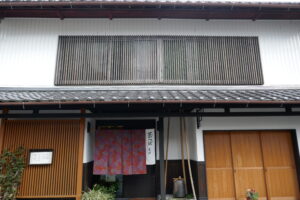Term archive

投稿タイプ:restaurants
Ayabe Onsen
Ayabe City's Kanbayashi area is surrounded by the natural scenery of the Japanese countryside. The area is also known for having the only National Treasure in northern Kyoto Prefecture, Komyo-ji Temple's Niomon Gate, and just beside it is Ayabe Onsen, with its flowing hot springs known for their skin-beautifying properties.
All of the ingredients used in the food here have been tasted and certified by our expert staff, who are well-versed in local ingredients, including local Kanbayashi chicken, with its distinctive rich fatty flavor and firm texture, and rice from a Kanbayashi farm.

投稿タイプ:restaurants
Torizo
The walls of Torizo are covered with posters of musicians, record jackets, and motorcycle photos. As you enter, you’ll hear a welcoming voice from the back of the restaurant, like being in an old record shop!
Torizo is an izakaya with a different style of fowl meat dishes. The owner, Mitsutaka Kondo, trained at the famous fowl restaurant Torinako in Fukuchiyama, and opened his own restaurant in 2013. There are elegant dishes using Kyoto-style soup stock that is full of flavor, with duck meat and green onions.

投稿タイプ:restaurants
Totogen
Totogen was established in the early Showa era (1926-1989) in Maizuru, a location that is as competitive as it gets when it comes to fish markets. Totogen procures local seafood directly from Maizuru’s fishing port, Tsuruga, and Amino Port in Kyotango. Chef Tetsuya Oishi prepares seasonal seafood like rock oysters in summer, shore plovers in spring and autumn, and crab in winter.

投稿タイプ:restaurants
Tsuruya Shokudo
Tsuruya Shokudo specializes in seafood, but also offers purple soba and ancient red rice udon. Look for the teahouse-like shop along the stone-paved street behind Motoise Kono Shrine. The restaurant also has views of Amanohashidate, one of Japan’s Three Scenic Views, which is fitting, since you can order a special rice bowl that uses ingredients from Miyazu Bay (the bay on one side of Amanohashidate).

投稿タイプ:restaurants
Suginoya
Suginoya is a sanuki udon (a type of udon typical of Kagawa Prefecture) specialty shop in Kyoto, on the northern edge of Amanohashidate. After 8 years of studying at a famous udon shop in Kagawa, the fourth generation owner of souvenir shop Suginoya, Masto Yamazaki, opened his own udon shop next to the souvenir shop in 2012. Even as Mr. Yamazaki adheres to the production methods, flavors, and hospitality that he learned at the Kagawa udon shop, he says he uses ingredients and seasoning from Miyazu because, in his own words, "Once I finished my studies are returned home, I felt that the chikuwa fish cakes and little jako fish are tastier here."

投稿タイプ:restaurants
Cucini
Cucini is run by a chef who decided to start his own farm. He continues to further his own education in nutrition and cuisine, and also works educating children about food. His focus on showcasing local ingredients doesn’t just stop at his farm, either: chef Iwanishi sources his ingredients from a variety of local farmers, including Kyotango farmers and fishermen, eggs from Mino Chicken Farm in nearby Ine, Yoka pigs from Toyooka (in neighboring Hyogo Prefecture), Tajima chicken (also from neighboring Hyogo Prefecture), and more. The result is cuisine with deep local flavor, ethical thinking, and close to zero carbon footprint from the food, which is good for the environment as well.

投稿タイプ:restaurants
Haneman Ramen
This popular ramen shop sees a line of people of all ages on weekdays, cyclists who come to Tango on weekends, and bikers touring the Tango Peninsula. Haneman has built a strong reputation for ramen with an excellent, light pork and chicken bone soup base with plenty of savory back fat. With eight types of ramen, including pork bone and soy sauce, Chinese soba, miso, salt, and seafood flavors, there's something for everyone. The noodles used are straight and thin, procured from Hiroshima and selected according to each type of soup.

投稿タイプ:restaurants
Funaya Shokudo Boathouse Dining
Funaya Shokudo is run by a long-established local inn and restaurant with lots of experience cooking local cuisine. The restaurant itself is located on the 2nd floor of the Ine Town Tourism Association, right in front of Ine Bay, so you can enjoy seasonal fish while looking out over the historic boat houses. Since opening in April 2018, it has become a popular spot for domestic and overseas tourists who want to try Ine’s hometown gourmet food.
The town of Ine is a treasure trove of delicious ingredients: in addition to seafood, this area's vegetables and rice are also excellent.

投稿タイプ:restaurants
Café & BB Guri
Guri is a word in the local dialect, meaning a "reef where fish school." The owner's sensibilities can be felt in the combination of the quiet café and and the lively restaurant. Food served here includes sweets and sandwiches that combine local Ine ingredients with the chef's flair. The balance of spices and the savory flavor of the fish in Guri's original flying fish sandwich is not to be missed.

投稿タイプ:restaurants
Organic Café Tentomushibatake
Tentomushi Batake (meaning "ladybug garden") is a café that opened on Umemoto Farm in May 2020. Mr. Umemoto is a pioneer of organic farming in Kyotango, and created this café/restaurant with organic food as the standard, as he believes that everyone should be able to experience eating organically. The café creates their own unique dishes using the farm’s organic vegetables, promoting the idea of organic eating to everyone.

投稿タイプ:restaurants
Yuzuki
At Yuzuki, guests can enjoy seasonal kaiseki course meals, hot pot dishes, summer-only beer gardens, and other meals made with seasonal Kyoto ingredients.
The large garden reflects the changing faces of the season—from cherry blossoms, to deep green, to colored leaves, to white snow—and the elegant dining room offers an out-of-the-ordinary experience for guests, with flowers arranged by the chef himself, "as if they were in the field."
Available drinks include draft beer, Japanese sake, shochu, cocktails, non-alcoholic beverages, and authentic coffee.

投稿タイプ:restaurants
Chatsubo Yoshida
At Chatsubo Yoshida, you can enjoy both matcha and a meal, either by having matcha hand-whisked for you by your seat, or by whisking your own matcha.
The store, which used to be a tea and tea utensil shop, has been renovated and remade as a café where you can casually enjoy matcha and some conversation.
Enjoy authentic matcha tea without worrying about difficult preparation methods.
